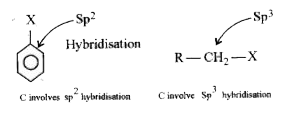Why aryl halide(haloarenes) are less reactive than alkyl halide(haloalkanes)? Solution in Punjabi
Haloarenes or aryl halide are less reactive than alkyl halide. The low reactivity in comparison to alkyl halide is due to the following reactions :
(i) Resonance effect : In aryl halide the electron pairs on the halogen atom are in conjugation with π-electrons of the ring and the following resonating structures are possible :

As a results resonance there is delocalisation of electron on C-Cl bond which acquires a partial double bond character. This is also evident from the contribution of structure III, IV and V. As a result the bond cleavage in aryl halide is less reactive towards nucleophilic substitution reaction.
(ii) Hybridisation : In haloalkane the carbon atom of the C X bond is sp3 hybridisation while in haloarene, the carbon atom attached to the halogen sp2 hybridisation. The hybridised carbon atom with a greater s-character is more electronegative. It can hold the electron pair of the bond more tightly that the sp3 hybridised carbon atom in alkyl halide with less s-character. Therefore C- X bond of aryl halide is shorter than alkyl halide.

(iii) Polarity of carbon-halogen bond : The sp2 hybridised carbon atom involve in C-X bond in haloarenes molecules is more electronegative than the sp3 hybrid carbon atom in alkyl halide. Therefore this sp2 hybridised carbon has less tendency to release electron to the Cl-atom and the C-Cl bond in aryl halide is less polar than in alkyl halide. This is supported by the fact that the dipole moment of chlorobenzene is 1.73 D while the dipole moment of chloro ethene is 2.05 D. Thus lesser the polarity of C-Cl bond, lesser is the reactivity.
Topper's Solved these Questions
- SOLVED MODEL TEST PAPER-3Book:ACCURATE PUBLICATIONChapter:SOLVED MODEL TEST PAPER-3Exercise:SECTION C
Explore 11 Videos
- SOLVED MODEL TEST PAPER-2Book:ACCURATE PUBLICATIONChapter:SOLVED MODEL TEST PAPER-2Exercise:SECTION D
Explore 11 Videos
- SURFACE CHEMISTRY Book:ACCURATE PUBLICATIONChapter:SURFACE CHEMISTRY Exercise:COMPREHENSION QUESTIONS
Explore 49 Videos
Similar Questions
Discuss the reaction and mechanism of acidic dehydration of ethyl alcohol to prepare ether.
View SolutionExplain Swarts reaction.
View SolutionRead the given passage and answers following questions :
There are mainly two type of adsorption of gases on solids. If accumulation of gases on the surface of solid occurs on account of weak vander waal forces, the adsorption is termed as physical adsorption. When gas molecules or atoms held to solid surface by chemical bonds, adsorption is termed as chemical adsorption. The chemical bonds may be covalent or ionic. Chemical adsorption involves a high energy of activation therefore it is referred as Activated adsorption. A physical adsorption at low temperature may pass into chemical adsorption temperature is increased.
What type of force exist in physical adsorption ?
View SolutionAryl halides are less reactive towards nucleophilic substitution reaction as compared to alkyl halides due to
View SolutionWhy are aryl halides less reactive towards nucleophilic substitution reactions than alkyl halides? How can we enhance the reactivity of aryl halides?
View Solutionऐरिल हैलाइड, ऐल्किल हैलाइडो की अपेक्षा नाभिक-स्नेही अभिकर्मक के प्रति कम क्रियाशील होते हैं, क्यों ?
View SolutionExplain, why aryl halides are less reactive than alkyl halides.
View SolutionAryl halides are less reactive than alkyl halides because of
View SolutionWhy are aryl halides less reactive towards nuclophilic substituition reaction than alkyl halides? How can be enhance the reactivity of aryl halides?
View SolutionIn general, alkyl halides are more reactive than aryl halides.
View SolutionIn general, alkyl halides are more reactive than aryl halides.
View SolutionWhy are aryl halides less reactive towards nucleophilic substitution reactions than alkyl halides? Explain
View SolutionWith the help of resonance show that aryl halides are lesser reactive than alkyl halides.
View SolutionWith the help of hybridisation show that aryl halides are lesser reactive than alkyl halides.
View Solutionऐरिल हैलाइड ऐल्किल हैलाइडों की अपेक्षा नाभिकरागी प्रतिस्थापन के प्रति कम क्रियाशील क्यों होते हैं? हम ऐरिल हैलाइडों की क्रियाशीलता कैसे बढ़ा सकते हैं?
View SolutionAryl halides are less reactive towards electrophiles than alkyl halides due to :
View Solution

